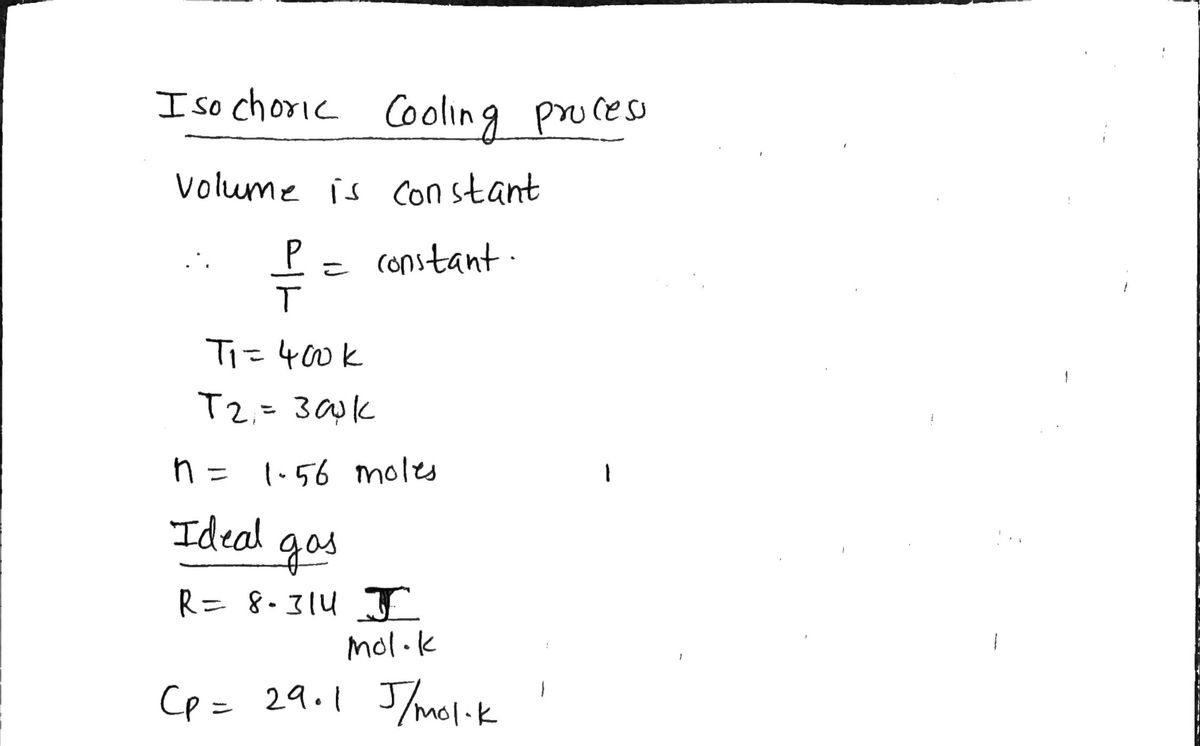1.56 moles of an ideal gas is placed in a piston and is subjected to the following changes. (a) The piston is locked so that the volume of the gas does not change, and is then cooled slowly (and reversibly!) from a temperature of 400 K to 300 K. What is the change in entropy, AS (in J/K), for this process? This is an example of an isochoric cooling process. (b) The external pressure around the piston is adjusted to match the internal pressure of the gas inside. The piston is now insulated from the surroundings (i.e. no heat exchange) and is unlocked. The external pressure is slowly (and reversibly!) increased allowing adiabatic contraction of the gas inside until its temperature has returned to 400 K. What is the change in entropy (in J/K) for this process? (c) What is the total change in entropy (in J/K) for these two processes, and in what way(s) are the physical properties of the gas (P, V, and T) different between the starting point and the end point? (You may find it useful to construct a PV-diagram for this two-step process.) Note: Assume that the gas has the same molar heat capacity as a monatomic ideal gas.
1.56 moles of an ideal gas is placed in a piston and is subjected to the following changes. (a) The piston is locked so that the volume of the gas does not change, and is then cooled slowly (and reversibly!) from a temperature of 400 K to 300 K. What is the change in entropy, AS (in J/K), for this process? This is an example of an isochoric cooling process. (b) The external pressure around the piston is adjusted to match the internal pressure of the gas inside. The piston is now insulated from the surroundings (i.e. no heat exchange) and is unlocked. The external pressure is slowly (and reversibly!) increased allowing adiabatic contraction of the gas inside until its temperature has returned to 400 K. What is the change in entropy (in J/K) for this process? (c) What is the total change in entropy (in J/K) for these two processes, and in what way(s) are the physical properties of the gas (P, V, and T) different between the starting point and the end point? (You may find it useful to construct a PV-diagram for this two-step process.) Note: Assume that the gas has the same molar heat capacity as a monatomic ideal gas.
Elements Of Electromagnetics
7th Edition
ISBN:9780190698614
Author:Sadiku, Matthew N. O.
Publisher:Sadiku, Matthew N. O.
ChapterMA: Math Assessment
Section: Chapter Questions
Problem 1.1MA
Related questions
Question

Transcribed Image Text:1.56 moles of an ideal gas is placed in a piston and is subjected to the following changes.
(a) The piston is locked so that the volume of the gas does not change, and is then cooled
slowly (and reversibly!) from a temperature of 400 K to 300 K. What is the change in
entropy, AS (in J/K), for this process? This is an example of an isochoric cooling process.
(b) The external pressure around the piston is adjusted to match the internal pressure of the
gas inside. The piston is now insulated from the surroundings (i.e. no heat exchange) and
is unlocked. The external pressure is slowly (and reversibly!) increased allowing adiabatic
contraction of the gas inside until its temperature has returned to 400 K. What is the
change in entropy (in J/K) for this process?
(c) What is the total change in entropy (in J/K) for these two processes, and in what way(s)
are the physical properties of the gas (P, V, and 7) different between the starting point
and the end point? (You may find it useful to construct a PV-diagram for this two-step
process.)
Note: Assume that the gas has the same molar heat capacity as a monatomic ideal gas.
Expert Solution
Step 1

Step by step
Solved in 4 steps with 4 images

Knowledge Booster
Learn more about
Need a deep-dive on the concept behind this application? Look no further. Learn more about this topic, mechanical-engineering and related others by exploring similar questions and additional content below.Recommended textbooks for you

Elements Of Electromagnetics
Mechanical Engineering
ISBN:
9780190698614
Author:
Sadiku, Matthew N. O.
Publisher:
Oxford University Press

Mechanics of Materials (10th Edition)
Mechanical Engineering
ISBN:
9780134319650
Author:
Russell C. Hibbeler
Publisher:
PEARSON

Thermodynamics: An Engineering Approach
Mechanical Engineering
ISBN:
9781259822674
Author:
Yunus A. Cengel Dr., Michael A. Boles
Publisher:
McGraw-Hill Education

Elements Of Electromagnetics
Mechanical Engineering
ISBN:
9780190698614
Author:
Sadiku, Matthew N. O.
Publisher:
Oxford University Press

Mechanics of Materials (10th Edition)
Mechanical Engineering
ISBN:
9780134319650
Author:
Russell C. Hibbeler
Publisher:
PEARSON

Thermodynamics: An Engineering Approach
Mechanical Engineering
ISBN:
9781259822674
Author:
Yunus A. Cengel Dr., Michael A. Boles
Publisher:
McGraw-Hill Education

Control Systems Engineering
Mechanical Engineering
ISBN:
9781118170519
Author:
Norman S. Nise
Publisher:
WILEY

Mechanics of Materials (MindTap Course List)
Mechanical Engineering
ISBN:
9781337093347
Author:
Barry J. Goodno, James M. Gere
Publisher:
Cengage Learning

Engineering Mechanics: Statics
Mechanical Engineering
ISBN:
9781118807330
Author:
James L. Meriam, L. G. Kraige, J. N. Bolton
Publisher:
WILEY